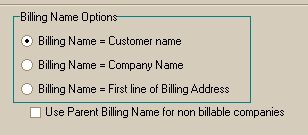SQLink - Customers
Customer Sync:
Definitions:
1) QB: QuickBooks® by Intuit®
2) SME: Service Management Professional (version 5) by High 5 Software™
3) SQLink: SME to QB synchronization program by High 5 Software™
Customers:
Customer syncing is bi-directional when using SQLink. Customer can be modified in either SME or QuickBooks and those changes will update the other application. As is always the case there will be some instances where the update cannot take place as expected. This will only happen when exporting SME changes to QuickBooks. For more information refer to the Customer errors & troubleshooting pages.
Note: If you are syncing SME with a QuickBooks company file that has the same customer list you will need to contact High5 Software to setup a test sync and address all issues prior to going ‘live’ with the sync.
Terms:
Initial Sync: refers to the initial import of QuickBooks lists into SME
Routine Sync: refers to syncing per the users business requirements and can be performed at any time.
Module Sync: refers to using the SQLink Data Functions Module sync to move SME information to QuickBooks.
Site/Job: Sites in SME = Jobs in QuickBooks ‘if’ the location is billing to a different location.
Billing Company: The location to which you are sending the invoice for payment.
Syncing:
Initial sync: The initial sync of SME and QuickBooks will bring all customer records from QuickBooks to SME. You have the option of excluding inactive customers. (It is recommended to bring in inactive customers as SME has provisions for viewing active customers, inactive customers, or all customers.)
Routine Sync: Once a customer is synchronized between SME and QuickBooks, changes can be made in either SME or QuickBooks and the changes will be reflected in the other program. Note: The SME data is exported/synced first, so in the rare case that a record is changed in both SME and QuickBooks, the SME changes will take place and the QuickBooks changes will be overwritten.
Guidelines:
It is a best practice to enter new customers in one application as this will minimize the chance of duplication.
Do not enter company names in SME in excess of 40 characters. (This is a QuickBooks limit). This shows in SQLink as an error on importing.
To change the Billing customer for a Site/Job in SME you must put QuickBooks in ‘Single User Mode’ and then run the synchronization logged in as Admin. (This is a QuickBooks limitation.) The alternative is to move the Site/Job in QuickBooks and then run a routine sync.
Mandatory steps for adding new customers:
A best practice is to Always fill out ‘ALL’ information when setting up new records as this will avoid unnecessary errors when syncing invoices.
The following Fields will sync:
Customer Name - QuickBooks
Account Number – QuickBooks or SME
Company Name – QuickBooks or SME
First Name, Last Name – QuickBooks or SME
Contact – QuickBooks or SME
Phone, Fax – QuickBooks or SME
Email – QuickBooks or SME
Billing Address – QuickBooks or SME (Note: Refer to Billing Address options below for details on Billing address setup.)
Shipping Address – QuickBooks or SME
Taxes – QuickBooks or SME
Terms – QuickBooks or SME
Sales Person – QuickBooks or SME
Customer Taxes:
Review the customer tax setup after creating the customer regardless of the application. If you create the customer in QuickBooks review the tax and set it to the appropriate taxing authority.
Note: (QuickBooks uses a dummy tax as the default when syncing with integrated applications.)
Note: QuickBooks does not provide for setting taxes on Sites/Jobs. The Billing location tax authority is used.
Note: After initial creation of the customer SME can NOT change the tax code in QUICKBOOKS. So if the tax code for the customer is changed in SME, it is NOT automatically changed in QUICKBOOKS, and must be manually changed in QUICKBOOKS.
Customer tax setting will override all item level settings. If the customer is tax exempt then the entire invoice will be tax exempt.
SQLink Billing Options:
- Open SQLink and go to File> Setup
- Click Edit
- You will see the following for Billing address export options:
- 
- Option one – Billing Name = Customer Name:
- Billing Name = Customer Name
- The Billing name in SME will be matched to the ‘Customer Name’ from QuickBooks.
- Billing Name = Company Name - The Billing Name will be matched to the ‘Company Name’ from QuickBooks.
- Billing Name = First Line of Billing Address - The Billing Name in SME will be matched to the First Line’ of the Billing Address Block. (This is because QuickBooks does not actually treat this as a company name field. They treat it as list of 5 address fields.)
- Use Parent Billing Name for non billable companies. - A non billable company is one that has the ‘Is Billable’ flag unchecked in SME. If this is unchecked the option that is chosen above will be used for the Billing Address.